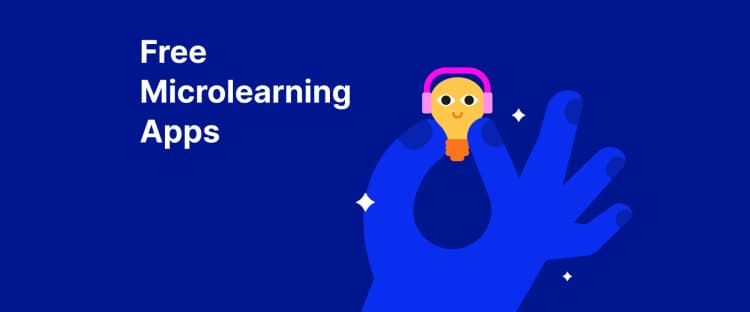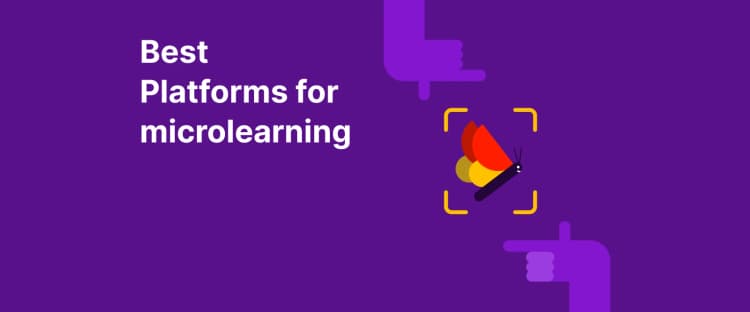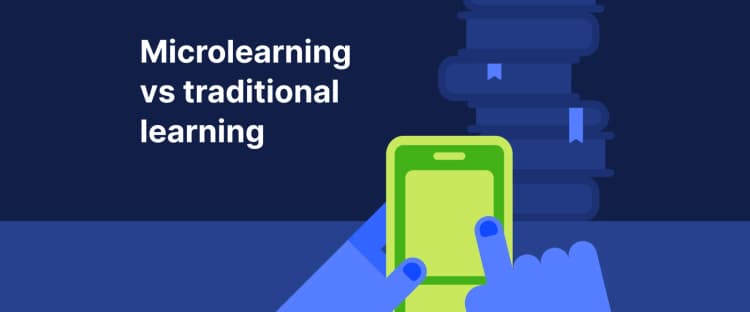Microlearning is a self-paced educational approach that delivers content in bite-sized formats, making it perfect for today's busy world. Instead of traditional long-form training sessions, microlearning focuses on short, focused lessons that can be easily consumed in a limited time.
What is microlearning?
Microlearning is an innovative educational approach that delivers microlearning content in concise, bite-sized modules, each targeting a specific learning objective.
The best microlearning apps are designed to match the modern learner’s fast-paced lifestyle, busy schedule, and shorter attention span.
Microlearning harnesses the principles of cognitive science and spaced repetition to promote efficient learner engagement, knowledge retention, and application in the corporate environment
Why is microlearning effective?
Microlearning aligns perfectly with today's digitally-transformed workflow, where information is abundant and attention spans are shrinking.
According to a study by Microsoft, the average human attention span dropped from 12 seconds in 2000 to 8 seconds in 2013, less than that of a goldfish. As such, traditional lengthy learning modules and training sessions are no longer effective.
Enter microlearning — its short and focused bite-sized learning nature caters to this new reality, making it an integral part of corporate e-learning strategies.
At its core, microlearning is about understanding how our memory works and using that knowledge to increase learning effectiveness. The principle behind microlearning rests on the "forgetting curve," a concept introduced by the German psychologist Hermann Ebbinghaus.
He discovered that the brain tends to forget information over time, with the sharpest decline occurring in the first 24 hours. But this is when microlearning can help. It provides small pieces of content on specific topics that can be quickly learned in short bursts and repeated, thus enhancing knowledge retention.

The science behind the bite-sized learning
According to a study by the Journal of Applied Psychology, microlearning enhances retention and performance by up to 20%. An eLearning Industry study found that learners can absorb and retain information 17% more efficiently when that data is presented in smaller units, or microlearning modules. Such statistics emphasize the effectiveness of microlearning in fostering learning and development, thus increasing team performance.
Microlearning isn't just about shrinking the size of learning content. It's about redesigning experiences to meet the modern on-demand needs and lifestyles. It's an approach that respects the individual’s time, provides flexibility, like on-demand mobile learning, and allows personalized learning paths with short videos, gamification, and simulations.
This learner-centric model is why microlearning is becoming increasingly popular in, and might we add, just in time for today’s corporate training and learning space.
Six best microlearning formats you should try
Microlearning platforms comprise various engaging formats and microlearning examples, each serving different learning needs and preferences:
Text: Bite-sized phrases or short paragraphs give essential information quickly and easily.
Images: Photos or illustrations, like infographics, visually represent concepts, aiding comprehension and retention.
Videos: Microlearning videos — short instructional or explanatory videos on specific topics — provide a dynamic way to present complex information.
Audio: Short audio clips or podcasts allow for learning on the go, even on a smartphone.
Tests and Quizzes: Quick assessments reinforce learning, shorten knowledge gaps, and provide feedback.
Games: Elearning courses in the form of simple games, simulations, or challenges engage learners, making learning fun and interactive.
Individually or combined, each of these formats can effectively facilitate microlearning, depending on the content and the learners' needs.
What are the benefits of microlearning?
Microlearning's rise to prominence in corporate learning is not by chance; it is a direct response to its unique advantages in the learning and development arena.
In today's fast-paced business environment, it enhances the efficiency of the learning process, boosts engagement, and facilitates knowledge retention.
Maximized time efficiency
Microlearning is speedy and on-demand catering to today's time-constrained learners. It offers bite-sized information that individuals can consume quickly.
According to eLearning Industry, microlearning requires 300% less time than traditional training while delivering the same amount of information, making it a perfect fit for busy professionals.

Effortless delivery
Microlearning is designed for accessibility, which plays a crucial role in ensuring continuous learning and development. Its digital nature and concise format make training sessions easy to deliver across various platforms, including mobile devices like smartphones.
Increased engagement
By breaking down information into digestible chunks, microlearning reduces cognitive load and makes learning sessions more enjoyable, increasing engagement.
A study by Axonify found that effective microlearning boosts voluntary participation by up to 50% compared to traditional e-learning methods.
Enhanced knowledge retention
Using spaced repetition, microlearning leverages the spacing effect with the forgetting curve to improve knowledge retention. It provides frequent, repeated exposure to content over time, helping transfer information from short-term to long-term memory.
Self-paced education
Microlearning caters to individual learning paces, accommodating different learning styles. This self-paced microlearning strategy increases learner satisfaction and effectiveness, as demonstrated by a LinkedIn study that found that 58% of employees prefer to learn at their own pace.
Learning on the go
The mobile-friendly nature of microlearning courses supports learning anytime, anywhere, turning downtime into productive learning time. In today’s mobile-first world, this is particularly relevant. According to a report by eFront, 70% of learners feel more motivated when training on a mobile device.
Personalized learning experience
Microlearning can be easily customized to suit individual learning needs, providing a more personalized and practical learning experience.
Headway's microlearning solution, tailor-made for business learning, exemplifies these advantages. The platform offers a variety of cost-effective content formats and supports learning on the go.
Hence it is an ideal choice for businesses looking to leverage the power of microlearning to enhance their corporate learning and development strategy.
What are the limitations of microlearning?
Despite its benefits, microlearning has challenges. When considering its implementation, it's essential to comprehend the intricacies involved to ensure its successful integration into your corporate learning strategy.
Complex topics
Microlearning, by its nature, deals with 'micro' or smaller, bite-sized pieces of information; it is less suited to tackle topics that require a deep dive. However, this doesn't rule out its use entirely for more intricate subjects.
Platforms like Headway have designed solutions that cleverly segment complex information into manageable learning modules, creating a journey of knowledge discovery rather than an overwhelming information dump.

Need for specialist expertise
Transforming comprehensive topics into concise, engaging, and effective learning nuggets demands a deep understanding of the subject matter and learning methodologies.
Headway offers a solution to this challenge by providing a range of expertly crafted courses, ensuring the content you deliver is engaging and effective in delivering learning outcomes.
While these challenges do exist, they are not insurmountable. Instead, they act as prompts for learning and development professionals to take a more strategic, considered approach to implementing microlearning.
Leverage microlearning tools with Headway

With a free microlearning app like Headway, you can absorb key insights from top nonfiction books, including 'Atomic Habits' by James Clear and 'The 48 Laws of Power' by Robert Greene, quickly and effectively. Its concise, 15-minute summaries are perfect to learn on-the-go and upskill your knowledge. In this guide, you'll discover the essence of microlearning, its efficacy, and strategies for its successful integration into the modern learner's self-growth journey.
Now that you know what microlearning is, you can break new information down into bite-sized chunks to enhance memory retention and improve learning outcomes. This learning style is a game-changer for knowledge-hungry individuals and organizations alike, as it increases professional performance and knowledge retention in a time-effective manner.
The Headway app is a perfect example of how microlearning can be applied to real-world learning. With over 1700 book summaries on self-growth, career, productivity, and more, Headway provides tailored learning paths you can align with your interests and goals.
Ready to boost your personal development and knowledge? Ready to replace doom scrolling with microlearning? Download the Headway app today and start your microlearning journey. Whether you're looking to enhance your skills, grow professionally, or expand your knowledge base, Headway makes learning easier and more accessible.
Frequently Asked Questions about microlearning
What is microlearning?
Microlearning is a learning method that delivers content in short, focused segments—typically 2 to 10 minutes long. It breaks down complex subjects into manageable, bite-sized lessons to make learning faster, easier, and more accessible.
How can I start microlearning?
Getting started is easy—download a microlearning app like Headway, Coursera Bite-Sized, or Blinkist, or explore platforms that offer short-form video lessons. Choose a topic that interests you and commit just a few minutes each day.
How long is a microlearning course?
Microlearning courses vary in length, but each individual lesson is usually between 5 to 15 minutes. A full course might consist of several micro lessons, allowing learners to progress at their own pace without feeling overwhelmed.
Is Headway microlearning?
Yes, Headway uses a microlearning approach. It condenses bestselling nonfiction books into 15-minute summaries, helping users absorb key insights quickly and efficiently—ideal for busy lifestyles or on-the-go learning.
Does microlearning actually work?
Absolutely. Studies show micro learning improves knowledge retention, boosts engagement, and fits better into modern routines. By focusing on one concept at a time, it helps learners grasp information more effectively.
Is micro learning worth it?
Yes, micro learning is highly valuable, especially for professionals, students, and lifelong learners. It saves time, increases productivity, and makes it easier to revisit and reinforce concepts as needed.
How long is a typical micro teaching session?
A typical micro teaching session lasts anywhere from 5 to 20 minutes. It's designed to focus on one specific skill or topic, making it perfect for rapid learning without mental fatigue.






